Home >> Feature Article |
| Follow us: |
Posted on : Oct 15, 2011
one special DASARA recalled
CASCADE OF COMPASSION – THE STORY OF THE SRI SATHYA SAI DRINKING WATER PROJECT FOR THE ANANTAPUR DISTRICT
by Prof. G. Venkataraman
Part 2
LISTEN TO THE AUDIO |
So Mr. Ramakrishna and Mr. Kondal Rao went around all over the district and tried to locate places where they could get water with very little fluorine. But how to get this water? Rain water, as it comes from above, doesn’t have any fluorine but there is so little rain in this region. So what they did was - they went around looking for places where they could draw rain water. One may say rain water is available only when there is rain, that's true, but rain water also flows through rivers and this water can be dammed. From the dams there can be canals and so on and so forth. Even if there is no rain there is subsoil water in the riverbeds. So they went around looking for irrigation dams and canals, and riverbeds where there was good subsoil water. And it is around these 'head sources' that they planned the drinking water projects.
The Modus Operandi of the Divine Magnum Opus
In brief they adopted three strategies. Strategy number one was to draw water from an irrigation canal and this can be done only during the season when there is water in the canal as water is released for irrigation only periodically not always. And when they draw water from that canal, they pump into a huge storage tank. And from there it is filtered and distributed. So in Scheme 1 water was drawn from an irrigation canal, stored in a summer storage tank and then distributed to the villages.
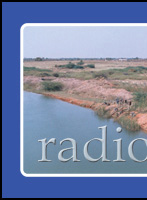    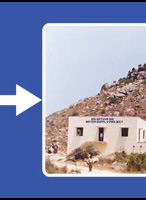 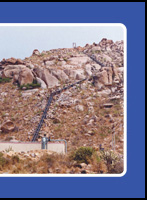 |
| River water flowing in an irrigation canal is drawn by an intake well using a pump (left) and sent through underground pipes to a huge storage tank tens of acres in area (center). Water is then pumped out, purified and then sent to a storage reservoir for distribution. (right) This is a pumping station that is sending water to a reservoir up a hill. |
In Scheme 2 there was one small dam across a river bed and a canal system that was called PABR (Penna Ahobilam Balancing Reservoir). They decided that since some water is stored there, it could be drawn, purified and distributed.
 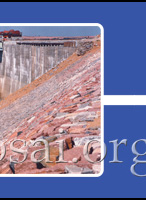 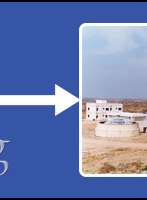 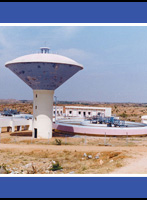  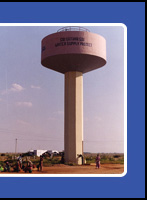 |
| Water from small dams was drawn purified and then distributed. |
In Scheme 3 the plan was to draw water from the bed of a river. Interestingly, we think that River Chitravathi that flows past Puttaparthi disappears somewhere into the Bukkapatnam Tank. Actually it goes all the way to Kadapa and joins River Penna. If we see a map we can find this.
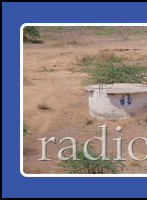  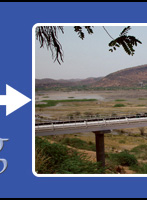 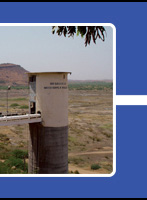 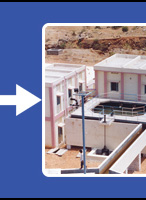  |
| Water was also drawn from river beds, purified and distributed |
So Mr. Ramakrishna and Mr. Kondal Rao decided to sink infiltration wells somewhere in River Chitravathi at the border of Kadapa because there was a good supply of subsoil water which is fluorine free.
So these were the 3 schemes based on which they decided to execute the water project - the basic idea being to draw water from these places and distribute it to as many as villages as possible.
However there was another problem: The elevation in Anantapur district is not flat as there are lots of hills and valleys, and in the North where there is water is at a slightly lower level than the South. Therefore to bring water from the North to the South water has to be pumped against gravity and this was a bit of a problem as it costs energy which automatically means more pumping stations and all sorts of things.
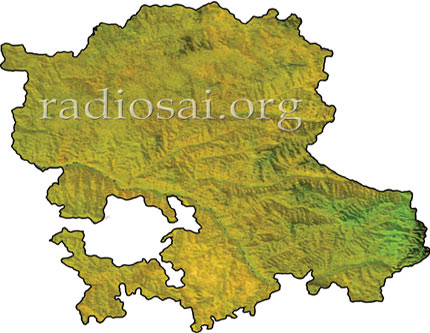 |
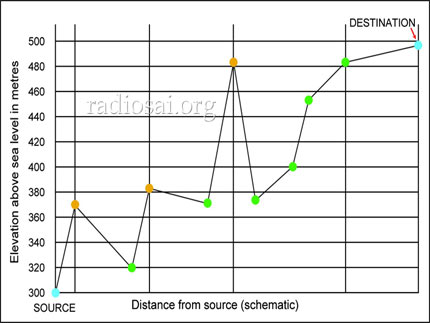 |
|
Relief map of Anantapur district showing the wide variations in elevation. From the map it should be clear that the south is at a higher elevation than the north. |
This schematic illustrates how typically all major sources were at a lower level than the places to be served. |
Nevertheless it had to be done as those were Swami’s orders and they decided to do it. So they prepared a plan, submitted it to Swami and waited for His approval.
Once the report was presented, Bhagawan approved it and said: “Go ahead and start immediately.”
So work began at several sectors simultaneously and not as is normally done, that is, one thing at a time. Swami did not believe in the later philosophy - ‘If work has to be done, do it and if you can, do it in all places simultaneously. Go ahead; I want it finished as quickly as possible’, that's Swami's way of working.
 |
 |
|
This map shows the rivers flowing through the district. These rivers are dry except during the rainy season. Most of the water tapping was done in the northern part. |
The blue colour in this map shows the regions served by Baba’s drinking water project for Anantapur district. |
 |
 |
 |
 |
 |
 |
 |
 |
| Seen here are some photographs taken during the construction stage. | |||||||
 |
 |
 |
 |
 |
 |
 |
 |
 |
 |
 |
 |
 |
 |
 |
 |
 |
 |
|
| This map shows how the rivers have been interconnected via canals to create various reservoirs. | This map shows the location of seven summer storage tanks, each of which supplies water to villages in the neighbourhood. |
 |
 |
 |
 |
 |
 |
 |
 |
| Construction work was carried out simultaneously in different sites | |||||||
 |
 |
 |
 |
 |
 |
 |
 |
| A summer storage tank under construction | |||||||
One very interesting thing about Swami is He was always rather impatient once He started a project. So much so, I used to say, Prof. Kasturi wrote a book called ‘Loving God’ but I am going to write a book called ‘Impatient God’! I have seen a lot of that impatience as Vice Chancellor especially.
So once the work started, Swami wanted somebody from the Central Trust to supervise constantly - this is something He always did. If He started a project and gave the contract to a company He wanted somebody from His side to see the work in progress regularly and report to Him as frequently as possible preferably daily. Back then during the Anantapur project Swami used to get daily reports.
Apart from that once a week or so Mr. Ramakrishna and Mr. Kondal Rao would come and show photographs and keep Swami abreast with the progress.
Work progressed very fast and once Swami was so keen to see it He was actually taken in a small plane belonging to the L&T; it took off from the Puttaparthi airport. Swami was away for 3 hours; He flew all over the construction sites and returned; He was very happy.
|
|
|||||||||
| A overhead reservoir under construction | Baba returning to Puttaparthi after flying over the various construction sites. |
 |
 |
 |
 |
 |
 |
 |
 |
| A water purification plant under construction. | |||||||
 |
 |
 |
 |
 |
 |
 |
 |
| Pipe laying was an important part of the project. In all close to 2,500 kilometers of pipe were laid during the project. Seen here are pictures depicting the enormity of the task of pipe laying. |
|||||||
 |
 |
 |
 |
 |
 |
 |
 |
 |
 |
 |
 |
 |
 |
 |
 |
 |
 |
 |
 |
 |
 |
 |
 |
 |
 |
 |
 |
 |
 |
 |
 |
 |
 |
 |
 |
 |
 |
 |
 |
 |
 |
 |
 |
 |
 |
 |
 |
The Project Unfolds in Record Time
This is what happened from March 95. Let's now come to November of that year. Incidentally that was the year of Swami’s 70th birthday; so it goes back about 15 years. In November 18, 1995 Swami held a function in the Poorna Chandra Hall; this time too Mr. P.V. Narasimha Rao was invited as the chief guest. And what was the function about? The inauguration of the Anantapur Summer Storage Tank; it’s a 60 acres or so huge tank which supplied water to the Anantapur town.
      |
| The picture above shows a long shot of one of the tanks. Seen below is the panoramic view of Anantapur Summer Storage Tank which extends over sixty acres |
  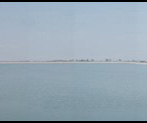   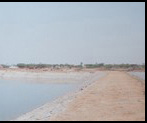 |
So Mr. Narasimha Rao came and sitting in the Poorna Chandra Hall, he pressed a button which was connected to the pumps in Anantapur (about 70 kilometres from Puttaparthi) and the pumps started working; water started coming from the taps. And somebody through wireless connection or telephone reported that the pumps have started working and water was flowing. Everybody clapped and Swami was smiling. It happened just nine months after He gave the order 'go'.
      |
| Pictures taken on November 18, 1995, on the occasion of the inauguration of the Anantapur Summer Storage Tanks. The inauguration was done by the then Prime Minister Mr. P.V. Narasimha Rao. A button was pressed which started the pumps in Anantapur seventy kilometers away, following which water started flowing. To mark the occasion the Prime Minister opened a small tap placed on the stage from which water flowed. |
      |
In those nine months about 80% of the Anantapur drinking water project, which is by the way a massive project, had been completed. In fact the project had so many aspects to it that a lot of people got the chance to inaugurate bits and pieces of it. While the Prime Minister got a small piece of the action the President of India got most of it and that happened on Swami's 70th Birthday in the Hill View Stadium in full public view. Oh! it was a gala function! And if I remember correct Swami was in a white robe. The President was present. Even the current Prime Minister was there as he had come to deliver the convocation address on the previous day. At that time Dr. Manmohan Singh (the future Prime Minister) was the Finance Minister while Dr. Shankar Dayal Sharma was the President of India.
      |
| On November 23, 1995, which marked the seventieth birthday of Baba, the then President of India Dr. Shankar Dayal Sharma formally inaugurated the rest of the Anantapur Drinking Water Scheme. Some residual works were left but were completed within the next four months, following which the water distribution scheme became fully operational. |
      |
For those who are not aware, Dr. Shankar Dayal Sharma was a devotee of Swami from a very long time and he used to come to Him regularly from the time he was first appointed Governor of Andhra Pradesh. At that time he had to come to Puttaparthi from Hyderabad, of course there was no airport in those days but he did not mind driving down or coming by train. Whatever it maybe he used to come to Him very often. Then he was made the Vice President of India and he continued to come frequently. Later he was made the President and the first thing he did was to go to Tirupati, get his head shaved and promptly show up in the Poorna Chandra Hall. It was a very sudden visit. So he was a frequent visitor to this place and he simply was thrilled to have the opportunity to inaugurate the entire Anantapur Drinking Water Project. Of course only 80% had been completed but then that’s more than 50%, so you can say it was almost done.
      |
| A photograph that shows people drawing water without any difficulty or hassle. |
      |
| Every village is provided with several taps so that no family has to go a long distance to fetch water. |
      |
| A typical scene of a village served by Baba's water project |
Now let me go to what happened afterwards. Normally after inauguration the tempo slackens and projects sort of drag on and on, but not in Swami’s case. He sat tight and made sure the project was completed by about March 1996. In one year the entire drinking water project was completed. It was a massive project and I’ll give the statistics shortly. So what did He do afterwards? Did He hand over the project to the government? No, He said we must test the system. So He told the Central Trust and L&T to run this project for more than a year and make sure that everything is working properly - not just from the machinery and the technology side but seeing if people are getting drinking water in their taps without any hassle; that’s very important. “I don’t want any hassle; people have suffered enough. So make sure about this,” He said.
Therefore L&T and the Central Trust worked out a very nice scheme for ensuring that pumps are run properly and water is distributed everyday, be it rainy season, summer, winter or whatever. If there were breakdowns, they made sure repairs were undertaken immediately. So in a sense the system was debugged shall I say, for nearly a year and a half and when Swami was sure that everything was alright, He decided to hand over the project to the people of the state as a gift.
But before that He wanted to make one last thing certain, that the body which took over and ran the Anantapur district waterworks would not be tied down by red tape. So Swami talked to the Chief Minister and said: “We will have a separate administrative committee that will report directly to the Chief Minister. This committee would be presided over by the district collector of Anantapur and would have representatives from the Central Trust, L&T, the government and the people.” Beneficiaries were also included, why? That was because if there are any problems they could come and openly tell the board; they didn't have to do it through petitions and so forth. And that was also the reason why this committee would not be under any government department; Swami was very particular about that. He did not spend crores of rupees for water supply to be interrupted indefinitely due to red tape. He did that project because He wanted to remove the sufferings of the people and He didn’t want the sufferings to come through the backdoor via red tape. He made sure about this institutionalisation and then said that we will now have a formal handover ceremony. And it is that ceremony which took place on the Dasara of 1997.
The Completed and Tested Water Supply Project Was Gifted to the People of the State
      |
| On October 11, 1997 Baba gifted the entire Anantapur Drinking Water Facility to the people of Andhra Pradesh. Justice Bhagawati, member of Baba’s Trust speaking on the occasion. |
That function as I told you was held in the afternoon around 3.00 p.m. or so. After the introductions and announcements, Justice Bhagawati who is now the chairman of the Central Trust, spoke on behalf of the Trust explaining why Swami did the project and so on and so forth. Then a number of others spoke – Mr. Kondal Rao, Mr. Ramakrishna and also Mr. Chakravarthi who was supervising the project from the Central Trust side. And interestingly all of them spoke only in Telugu, and there were no translations. Mr. Chakravarthi can converse fluently in Telugu but giving a stage speech in proper non-colloquial Telugu is a challenging task even for him. He therefore prepared a speech and read it out and came through unscathed. And after that the Chief Minister of Andhra Pradesh spoke and he did it from his heart.
      |
| Chief Minister of Andhra Pradesh, Mr. Chandra Babu Naidu accepting the facilities on behalf of the state. |
Basically this is what he said, “All this work ought to have been done by the government but the government failed to do it and Swami has done it.” He openly admitted it. He was sorry about it, and also a bit ashamed, but he was grateful to Swami.
And Swami spoke last as always and made a very important point and that is what I would now like to recall. He said: “All are the same to me. I have absolutely no distinctions based on colour, creed, race, cast, religion or nationality. Wherever it is if people are suffering I cannot bear and I will do whatever I can to help them.” That is the important point. He did not talk about the statistics; He did not say 2500 kilometres of pipes were laid. He left all that to the others. He said: “I did this project because I wanted to remove the suffering of people, no one had attempted to do it. I could not see the people in pain, so I intervened. Now I am giving it to you people with My blessings.”
      |
| Delivering a discourse during that occasion, Baba declared that He was always ready to help anyone in need, without consideration of caste, creed, race, religion or nationality. |
Now at this stage I want to give you some statistics because they are very impressive. Swami has done quite a few water projects after the one in Anantapur district. He did projects in Mahboobnagar, Chennai and then in East and West Godavari. So it makes it exactly half a dozen projects. I have talked to Mr. Ramakrishna and he said, “Of all these projects Anantapur still continues to be one of the most complex water projects we have done so far.”
I’ll come to the cause last. Swami said give water to as many villages as possible. And how many villages were covered by this project? 731! He said give water to as many people as possible. How many people receive the benefit of safe drinking water? About a million people! How many summer storage tanks were there? Seven! How many infiltration wells were sunk? 15!
      |
| (Above) A collection well where a pump sucks out the water from all the infiltration wells and sends it further for distribution. (Below) Water being drawn from an irrigation dam via three vertical pipes. |
      |
How many booster stations were there? (These are stations which boosted the water from ground level to higher level, remember water had to be pumped from north to south against gravity.) There are 32 booster stations. There were 6 water treatment plants where water was purified. There were 191 overhead reservoirs or tanks whose capacity varied from 40,000 to 300,000 litres. And there were 133 ground level reservoirs of various sizes.
      |
| A close-up view of the pump house (above).This circular tank (below) is used for precipitating out solid contaminants. This is one of the many processes involved in the purification of the water before it is distributed. |
      |
And by the way the total cost of the project in US dollars of 1995 was 70 million. In today’s dollars it would be much more, maybe 90 million or 100 million I don’t know the extent to which dollar has become weaker. 70 million is no small amount, in fact at that point of time no private charitable trust had executed a water project of this magnitude anywhere in the world. That’s not all. For the first time in India, villages that are over a 100 kilometres away from the water source got purified water. And by the way if you have to distribute water to 731 villages it calls for a lot of pipe laying. You know how much of piping length was there? 2,500 kilometres!
      |
| The water drawn from a dam is taken via the pipe seen above, along the wall of the dam. |
      |
 |
| This graphic is based on a photograph taken at a purifying and central distribution plant (shown in yellow above). As can be seen, a large number of villages are served. It is worthy of note that the farthest village is several tens of kilometers from the main source. Also can be seen several icons representing intermediate stages in the distribution process. |
 |
 |
 |
 |
 |
 |















